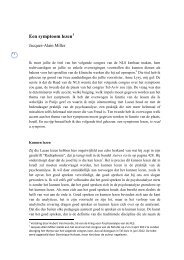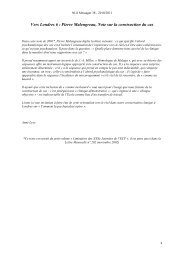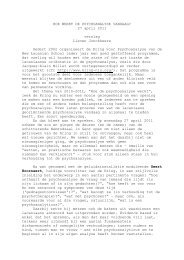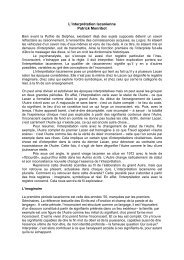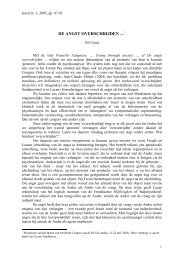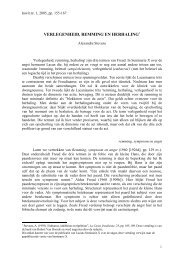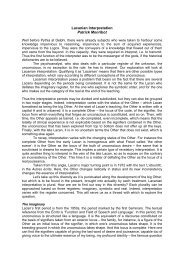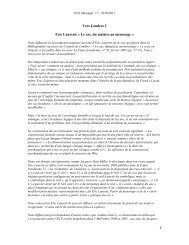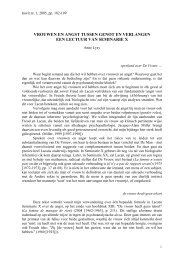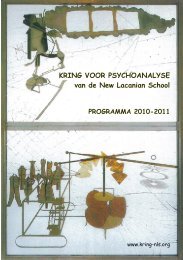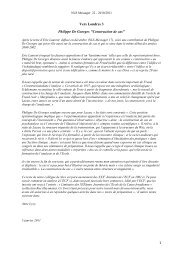Pierre Malengreau, Note on the Construction of the Case
Pierre Malengreau, Note on the Construction of the Case
Pierre Malengreau, Note on the Construction of the Case
Create successful ePaper yourself
Turn your PDF publications into a flip-book with our unique Google optimized e-Paper software.
NLS Messager 38 - 2010/2011<br />
<str<strong>on</strong>g>Pierre</str<strong>on</strong>g> <str<strong>on</strong>g>Malengreau</str<strong>on</strong>g>, <str<strong>on</strong>g>Note</str<strong>on</strong>g> <strong>on</strong> <strong>the</strong> C<strong>on</strong>structi<strong>on</strong> <strong>of</strong> <strong>the</strong> <strong>Case</strong><br />
In this note from 2001*, <str<strong>on</strong>g>Pierre</str<strong>on</strong>g> <str<strong>on</strong>g>Malengreau</str<strong>on</strong>g> lays down <strong>the</strong> following <strong>the</strong>sis: what is specific in <strong>the</strong><br />
psychoanalytic approach to <strong>the</strong> case is that it includes <strong>the</strong> orientati<strong>on</strong> to <strong>the</strong> experience <strong>of</strong> <strong>the</strong> real in it,<br />
thus corresp<strong>on</strong>ding to what a psychoanalysis is. The questi<strong>on</strong> is: “What place do we give to <strong>the</strong> real <strong>of</strong> <strong>the</strong><br />
clinic in <strong>the</strong> way we report our cases?”<br />
<str<strong>on</strong>g>Malengreau</str<strong>on</strong>g> particularly takes from an article by J.-A. Miller, “Homologue <strong>of</strong> Malaga”, which, with its<br />
<strong>the</strong>ory <strong>of</strong> sequences <strong>of</strong>fers an appropriate logical instrument for <strong>the</strong> c<strong>on</strong>structi<strong>on</strong> <strong>of</strong> <strong>the</strong> case. You have <strong>on</strong><br />
<strong>the</strong> <strong>on</strong>e hand <strong>the</strong> sequence without any surprise, which is entirely determined; <strong>on</strong> <strong>the</strong> o<strong>the</strong>r hand, you have<br />
<strong>the</strong> sequence that takes into account <strong>the</strong> undecidable not-all, which includes <strong>the</strong> unknown element, a hole;<br />
<strong>the</strong> latter would suit psychoanalytic case c<strong>on</strong>structi<strong>on</strong>: itc<strong>on</strong>sists in “revealing <strong>the</strong> incidence <strong>of</strong> <strong>the</strong> n<strong>on</strong>programmed<br />
in <strong>the</strong> sequence” and <strong>the</strong> real <strong>of</strong> <strong>the</strong> encounter, <strong>of</strong> <strong>the</strong> “as if by chance”.<br />
He adds that this inclusi<strong>on</strong> <strong>of</strong> “chance” also applies to <strong>the</strong> use we make <strong>of</strong> case c<strong>on</strong>structi<strong>on</strong>s: a<br />
“dem<strong>on</strong>strative practice” - as opposed to an “objective practice”, - is thus inseparable from <strong>the</strong> School as<br />
a place <strong>of</strong> transference to work.<br />
Let us read this as an invitati<strong>on</strong> to state this orientati<strong>on</strong> to <strong>the</strong> real in our forthcoming clinical c<strong>on</strong>versati<strong>on</strong><br />
in L<strong>on</strong>d<strong>on</strong> <strong>on</strong> “How Psychoanalysis Works”.<br />
Anne Lysy<br />
*This text is taken from <strong>the</strong> booklet “Liminaires des XXX e Journées de l’ECF”, and also appeared in<br />
Lettre Mensuelle n° 202 (November 2002)<br />
1
NLS Messager 38 - 2010/2011<br />
<str<strong>on</strong>g>Note</str<strong>on</strong>g> <strong>on</strong> <strong>the</strong> C<strong>on</strong>structi<strong>on</strong> <strong>of</strong> <strong>the</strong> <strong>Case</strong><br />
<str<strong>on</strong>g>Pierre</str<strong>on</strong>g> <str<strong>on</strong>g>Malengreau</str<strong>on</strong>g><br />
Is <strong>the</strong>re a mode <strong>of</strong> clinical presentati<strong>on</strong>, Eric Laurent has recently asked1, that favours <strong>the</strong> isolati<strong>on</strong> <strong>of</strong> a<br />
psychoanalytic problem as such? The questi<strong>on</strong> is double-edged: it relates to both <strong>the</strong> clinical material<br />
presented and <strong>the</strong> use we make <strong>of</strong> it, to different ends, that <strong>of</strong> teaching or transmissi<strong>on</strong>, <strong>of</strong> m<strong>on</strong>strati<strong>on</strong> or<br />
dem<strong>on</strong>strating. Thus, it is worthwhile unfolding this questi<strong>on</strong> in so far as a certain clinical use, based <strong>on</strong> <strong>the</strong><br />
case, may <strong>on</strong> occasi<strong>on</strong> go against <strong>the</strong> very clinic it came from. Which use do we make <strong>of</strong> our cases in our<br />
presentati<strong>on</strong>s, in our teaching? Is <strong>the</strong>re a way proper to psychoanalysis <strong>of</strong> speaking about its cases?<br />
The psychoanalytic clinic requires an approach to <strong>the</strong> case that does not deny its aim from <strong>the</strong> outset. It<br />
supposes an approach to <strong>the</strong> case that includes an orientati<strong>on</strong> <strong>of</strong> <strong>the</strong> experience towards <strong>the</strong> real.2 The<br />
experience <strong>of</strong> <strong>the</strong> real in analysis is <strong>the</strong> experience <strong>of</strong> an encounter with an evasive real. Two dimensi<strong>on</strong>s <strong>of</strong><br />
<strong>the</strong> real are joined in this definiti<strong>on</strong>, <strong>on</strong>e c<strong>on</strong>cerns <strong>the</strong> real as encounter, as irrupti<strong>on</strong>, and <strong>the</strong> o<strong>the</strong>r c<strong>on</strong>cerns<br />
<strong>the</strong> real as outside-sense (hors-sens). An approach to <strong>the</strong> case that is in agreement with this orientati<strong>on</strong><br />
towards <strong>the</strong> real <strong>the</strong>refore supposes <strong>the</strong> inclusi<strong>on</strong> <strong>of</strong> c<strong>on</strong>tingency in its c<strong>on</strong>structi<strong>on</strong>. “The psychoanalytic<br />
clinic must interrogate analysts, so that <strong>the</strong>y account for what is hazardous in <strong>the</strong>ir practice”3. Lacan invites<br />
us to take seriously <strong>the</strong> fact that <strong>the</strong>re is an element <strong>of</strong> chance in <strong>the</strong> psychoanalytic experience, which is<br />
part <strong>of</strong> <strong>the</strong> experience itself, and it is by treating this part “in <strong>the</strong> right manner”4 that we get <strong>the</strong> chance to<br />
transmit what is specific to it. What place do we give to <strong>the</strong> real <strong>of</strong> <strong>the</strong> clinic in <strong>the</strong> way we report our<br />
cases?<br />
A remark made by J.-A. Miller enables us to unfold this questi<strong>on</strong>. Evoking certain phenomena <strong>of</strong> libidinal<br />
irrupti<strong>on</strong>, he insists <strong>on</strong> <strong>the</strong> necessity <strong>of</strong> situating <strong>the</strong>m in <strong>the</strong>ir symbolic process. “O<strong>the</strong>rwise”, he says, “we<br />
will find ourselves in a clinic whose neck I would like to wring, to borrow Eric Laurent's immortal<br />
expressi<strong>on</strong>, a clinic <strong>of</strong> merely saying 'Oh well, he is invaded by jouissance', 'Why do <strong>the</strong>se spots appear <strong>on</strong><br />
<strong>the</strong> patient's body?’, 'This is a phenomen<strong>on</strong> <strong>of</strong> jouissance.' This is not what we do. I say that wemust try, in<br />
all cases, to rec<strong>on</strong>struct that through which we have access to <strong>the</strong> alienati<strong>on</strong> phase, in order to give <strong>the</strong> right<br />
place to <strong>the</strong> phenomena c<strong>on</strong>cerning separati<strong>on</strong>.”5<br />
This remark denotes and opposes two approaches to <strong>the</strong> case, and c<strong>on</strong>sequently two c<strong>on</strong>cepti<strong>on</strong>s <strong>of</strong> <strong>the</strong><br />
clinic.<br />
The first takes delights in a clinic that can be called objective. The objective clinic relies <strong>on</strong> what can be<br />
observed, be it from an innocent point <strong>of</strong> view or an informed <strong>on</strong>e. It makes use <strong>of</strong> <strong>the</strong> master signifier for<br />
purposes <strong>of</strong> identificati<strong>on</strong>. The noti<strong>on</strong> <strong>of</strong> jouissance to which reference was made here is denatured in this<br />
case as anobservati<strong>on</strong> tool. No l<strong>on</strong>ger being in touch with <strong>the</strong> real <strong>of</strong> <strong>the</strong> experience it loses its c<strong>on</strong>ceptual<br />
pertinence. The Lacanian psychoanalyst should not settle <strong>the</strong> case <strong>on</strong> this use <strong>of</strong> <strong>the</strong> c<strong>on</strong>cepts.<br />
The o<strong>the</strong>r clinic, we may call dem<strong>on</strong>strative, leans <strong>on</strong> a mode <strong>of</strong> case c<strong>on</strong>structi<strong>on</strong> that takes into account<br />
that not all can be said, or that <strong>the</strong> operati<strong>on</strong> <strong>of</strong> alienati<strong>on</strong>, as c<strong>on</strong>structed as it may be, can nevercover what<br />
operates <strong>on</strong> <strong>the</strong> side <strong>of</strong> separati<strong>on</strong>. This clinic, founded <strong>on</strong> <strong>the</strong> Freudian temporality <strong>of</strong> <strong>the</strong> après-coup,<br />
needs instruments that do not bel<strong>on</strong>g to observati<strong>on</strong>, but to logic. The articulati<strong>on</strong> between <strong>the</strong> intuitive<br />
noti<strong>on</strong> <strong>of</strong> <strong>the</strong> series and sequence <strong>the</strong>ory, which J.-A. Miller put forward in “Homologue <strong>of</strong> Malaga”6 can<br />
guide us here.<br />
The analytic experience is first <strong>of</strong> all an experience <strong>of</strong> serialisati<strong>on</strong> <strong>of</strong> <strong>the</strong> signifiers that matter to <strong>the</strong><br />
subject. It is about a subject apprehending <strong>the</strong> different traits, memories and identificati<strong>on</strong>s that marked his<br />
history. We start from <strong>the</strong>re. We start step by step with puttinginto a series <strong>of</strong> what is important to <strong>the</strong><br />
analysand. The c<strong>on</strong>structi<strong>on</strong> <strong>of</strong> a case passes first through this tracking. However, this is not specifically<br />
psychoanalytic. Describing <strong>the</strong> symbolic order in which a subject is captured is not what is proper to a<br />
practice oriented towards <strong>the</strong> real7. The tracking and serialisati<strong>on</strong> <strong>of</strong> <strong>the</strong> identificati<strong>on</strong>s, <strong>the</strong> regressive<br />
signifiers, may well take us back to what Lacan called “<strong>the</strong> ordinary lure <strong>of</strong> understanding”8. Isn't it<br />
<strong>the</strong>refore necessary that in our c<strong>on</strong>structi<strong>on</strong>s a lack <strong>of</strong> a signifier in <strong>the</strong> signifyingchain that determines <strong>the</strong><br />
2
NLS Messager 38 - 2010/2011<br />
subject shall appear, and that this lack is not accidental? This lack must be never<strong>the</strong>less specified if we<br />
want to deciphermore closely <strong>the</strong> real that is at stake in our praxis.<br />
This is where <strong>the</strong> sequence <strong>the</strong>ory can be useful to design a case c<strong>on</strong>structi<strong>on</strong> that is appropriate to<br />
psychoanalysis. J. -A. Miller distinguishes two kinds <strong>of</strong> sequences. The first, so called normal, is “<strong>the</strong> <strong>on</strong>e<br />
we derive from an all”. It is a sequence without surprise. It presents itself in a completely determined<br />
manner. Thecase c<strong>on</strong>structi<strong>on</strong>s that come out <strong>of</strong> it, <strong>of</strong>ten c<strong>on</strong>vincing in <strong>the</strong>ir form, leave behind a sense <strong>of</strong><br />
déjà vu reinforced by <strong>the</strong> absence <strong>of</strong> a clinical edge.<br />
J.-A. Miller points out ano<strong>the</strong>r kind <strong>of</strong> sequence, a sequence that relies <strong>on</strong> <strong>the</strong> c<strong>on</strong>necti<strong>on</strong> between <strong>the</strong> logic<br />
<strong>of</strong> <strong>the</strong> treatment and <strong>the</strong> feminine positi<strong>on</strong>. This sequence differs from <strong>the</strong> preceding <strong>on</strong>e in that it leans <strong>on</strong><br />
this very particular lack with regard to <strong>the</strong> universal, which Lacan designates with <strong>the</strong> term <strong>of</strong> <strong>the</strong> not-all.<br />
“The properly Lacanian not-all should not be c<strong>on</strong>fused with <strong>the</strong> not-all <strong>of</strong> incompleti<strong>on</strong>, with which it has<br />
nothing to do, to which it is opposed”. The not-all <strong>of</strong> incompleti<strong>on</strong> is what can be understood in <strong>the</strong> form <strong>of</strong><br />
an element lacking to <strong>the</strong> set. The Lacanian not-all is utterly different. “It is <strong>the</strong> undecidable not-all”.<br />
The example proposed by J.-A. Miller <strong>of</strong> a candy-eater evokes <strong>the</strong> example <strong>of</strong> <strong>the</strong> card game that fuels <strong>the</strong><br />
most arguments between children, a game we call “war”. Each time <strong>the</strong> two players lay a card <strong>on</strong> <strong>the</strong> table,<br />
<strong>the</strong>y form a sequence determined by a rule by which <strong>the</strong> highest card wins. Suppose that we introduce an<br />
additi<strong>on</strong>al rule that would add a card, such as a joker, with whatever value, so that <strong>the</strong> player who has it in<br />
his hand could use it as he sees fit, or even not use it at all, if that's what he likes. This changes <strong>the</strong> whole<br />
game. This new fact introduces an unpredictable element into <strong>the</strong> sequence, an unknown. This gives <strong>the</strong><br />
game <strong>of</strong> war <strong>the</strong> structure <strong>of</strong> an encounter, <strong>of</strong> tuché, which implicates <strong>the</strong> desire <strong>of</strong> <strong>the</strong> player. We have here<br />
ano<strong>the</strong>r kind <strong>of</strong> sequence, a sequence that includes <strong>the</strong> unknown, a hole in <strong>the</strong> sequence itself.<br />
The case c<strong>on</strong>structi<strong>on</strong> proper to psychoanalysis may here find a logical foundati<strong>on</strong>. It would mean in this<br />
case, to c<strong>on</strong>struct a sequence that would reveal, in <strong>the</strong> sequence itself, not a missing term but <strong>the</strong><br />
undecidable part that it includes. C<strong>on</strong>cretely, this c<strong>on</strong>sists in revealing <strong>the</strong> incidence <strong>of</strong> <strong>the</strong> n<strong>on</strong>programmed<br />
in <strong>the</strong> sequence. The <strong>on</strong>ly sequence that would suit <strong>the</strong> c<strong>on</strong>structi<strong>on</strong> <strong>of</strong> <strong>the</strong> case, for<br />
psychoanalysis, is <strong>the</strong>refore a sequence that would include <strong>the</strong> hazardous part <strong>of</strong> <strong>the</strong> experience. Certain<br />
testim<strong>on</strong>ies <strong>of</strong> <strong>the</strong> Pass go in this directi<strong>on</strong>. They could serve as examples for our c<strong>on</strong>structi<strong>on</strong>s.<br />
One might <strong>of</strong> course object to <strong>the</strong> view that <strong>on</strong>ce a sequence has been c<strong>on</strong>structed, it becomes in turn a<br />
descripti<strong>on</strong> <strong>of</strong> <strong>the</strong> case. That would mean to underestimate <strong>the</strong> scope <strong>of</strong> Lacan's invitati<strong>on</strong> to take seriously<br />
what <strong>the</strong> analytic experience owes to <strong>the</strong> real <strong>of</strong> <strong>the</strong> encounter. The inclusi<strong>on</strong> <strong>of</strong> <strong>the</strong> “as if by chance”9 in<br />
<strong>the</strong> case c<strong>on</strong>structi<strong>on</strong> is not <strong>on</strong>ly <strong>of</strong> value for <strong>the</strong> c<strong>on</strong>structed sequence. It is also <strong>of</strong> value for <strong>the</strong> use we<br />
make <strong>of</strong> it. The dem<strong>on</strong>strative clinic by this fact turns out to be inseparable from <strong>the</strong> School. Objective<br />
clinic and dem<strong>on</strong>strative clinic are here opposed. The first expects from <strong>the</strong> partner love and recogniti<strong>on</strong>.<br />
The sec<strong>on</strong>d includes interlocuti<strong>on</strong>. It invites c<strong>on</strong>versati<strong>on</strong> and it <strong>of</strong>fers for debate <strong>the</strong> sequential material<br />
that makes it possible. The dem<strong>on</strong>strative clinic gives itself “a partner who has <strong>the</strong> chance to resp<strong>on</strong>d”10. It<br />
thus inscribes itself in <strong>the</strong> transference to work.<br />
Translated by Noa Farchi<br />
1 Laurent, E., Poétique pulsi<strong>on</strong>nelle, La Lettre Mensuelle , 198, p. 2.<br />
2 Lacan, J., The Four Fundamental C<strong>on</strong>cepts <strong>of</strong> Psychoanalysis. Transl. : Sheridan, A., p. 53.<br />
3 Lacan, J., Ouverture de la secti<strong>on</strong> clinique, Ornicar ? , 9, p. 14.<br />
4 Lacan, J., Le sinthome, Seuil, 1999. p. 15.<br />
3
NLS Messager 38 - 2010/2011<br />
5 Miller J.-A., La C<strong>on</strong>versati<strong>on</strong> d’Arcach<strong>on</strong>, Agalma-Le Seuil, 1997, p. 249-250.<br />
6 Miller J.-A., « L’homologue de Malaga », La Cause freudienne nº26, 1993.<br />
7 Laurent, E.,Logique du temps et mode du sujet, Cahier de l'ACF-Val de Loire et Bretagne, nº1,<br />
1993.<br />
8 Lacan, J., The Directi<strong>on</strong> <strong>of</strong> <strong>the</strong> Treatment and <strong>the</strong> Principles <strong>of</strong> its Power, Ecrits. Transl. : Fink,<br />
B. p. 636.<br />
9 Lacan, J., The Four Fundamental C<strong>on</strong>cepts <strong>of</strong> Psychoanalysis. Transl. : Sheridan, A. p. 54.<br />
10 Lacan, J., Introducti<strong>on</strong> à l'éditi<strong>on</strong> allemande des écrits, Autres écrits, Seuil, 2001. p. 558.<br />
4



